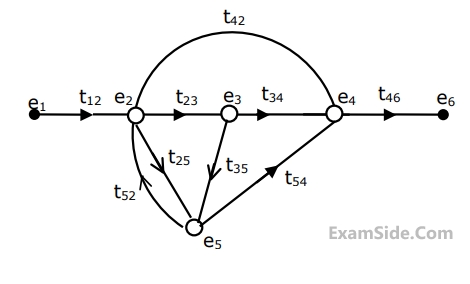1
GATE ECE 2001
Subjective
+5
-0
A feedback control system is shown in figure
 (a) Draw the signal-flow graph that represents the system.
(a) Draw the signal-flow graph that represents the system.
(b) Find the total number of loops in the graph and determine the loop-gains of all the loops.
(c) Find the number of all possible combination of non-touching loops taken two at a time.
(d) Determine the transfer function of the system using the signal-flow graph.
 (a) Draw the signal-flow graph that represents the system.
(a) Draw the signal-flow graph that represents the system.(b) Find the total number of loops in the graph and determine the loop-gains of all the loops.
(c) Find the number of all possible combination of non-touching loops taken two at a time.
(d) Determine the transfer function of the system using the signal-flow graph.
2
GATE ECE 1998
Subjective
+5
-0
Draw a signal flow graph for the following set of algebraic equations:
$$$\begin{array}{l}y_2=ay_1-\;gy_3\\y_3=ey_2+\;cy_4\\y_4=by_2-dy_4\end{array}$$$
Hence, find the gains $$\frac{y_2}{y_1}$$ and $$\frac{y_3}{y_1}$$.
3
GATE ECE 1994
Subjective
+5
-0
Reduce the signal flow graph shown in fig. below, to obtain another graph which does not contain the node e5.Also, remove any self-loop from the resulting graph.


Questions Asked from Signal Flow Graph and Block Diagram (Marks 5)
Number in Brackets after Paper Indicates No. of Questions
GATE ECE Subjects
Network Theory
Control Systems
Electronic Devices and VLSI
Analog Circuits
Digital Circuits
Microprocessors
Signals and Systems
Representation of Continuous Time Signal Fourier Series Fourier Transform Continuous Time Signal Laplace Transform Discrete Time Signal Fourier Series Fourier Transform Discrete Fourier Transform and Fast Fourier Transform Discrete Time Signal Z Transform Continuous Time Linear Invariant System Discrete Time Linear Time Invariant Systems Transmission of Signal Through Continuous Time LTI Systems Sampling Transmission of Signal Through Discrete Time Lti Systems Miscellaneous
Communications
Electromagnetics
General Aptitude